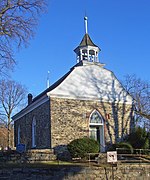Hudson Valley Writers Center
Repurposed railway stations in the United StatesWestchester County, New YorkWriters' centres and houses
The Hudson Valley Writer Center is a non-profit literary arts organization in Philipsburg Manor, Sleepy Hollow, NY. It was established on August 5, 1988, by Margo Taft Stever, a Sleepy Hollow poet, with the assistance of the Westchester Council of Arts, and moved into its permanent home at the Philipse Manor Railroad Station in 1996. The center hosts over 40 readings by poets, fiction and non-fiction authors, and playwrights over the course of a year, as well as popular recurring monthly events like Open Mic. They also offer workshops and guest readings and publish chapbooks annually under its imprint, Slapering Hol Press.
Excerpt from the Wikipedia article Hudson Valley Writers Center (License: CC BY-SA 3.0, Authors).Hudson Valley Writers Center
Riverside Drive,
Geographical coordinates (GPS) Address Nearby Places Show on map
Geographical coordinates (GPS)
| Latitude | Longitude |
|---|---|
| N 41.0946 ° | E -73.8695 ° |
Address
Hudson Valley Writer's Center
Riverside Drive 78
10591
New York, United States
Open on Google Maps








